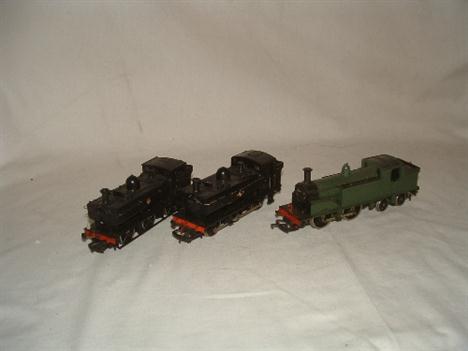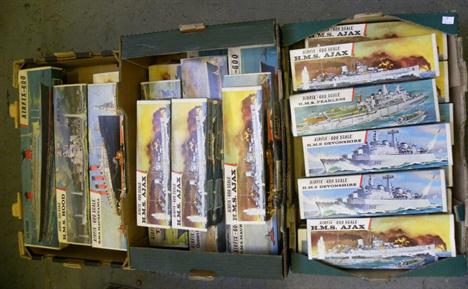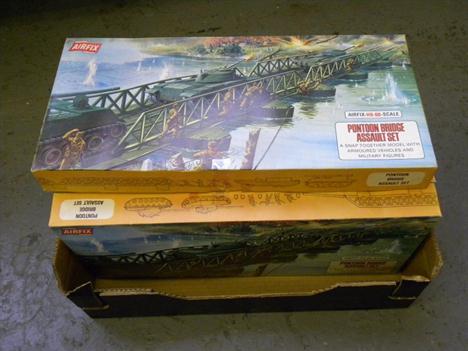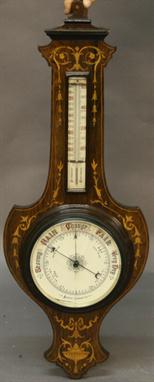HORNBY/MAINLINE 3 x Tank Engines - a Hornby and a Mainline Class 57XX 0-6-0PT repainted BR Black and numbered/detailed 3650 and 7779 respectively (Good bodies on Excellent Motorised chassis) and a R754 M7 0-4-4T repainted Green with scale bogie wheels and left unumbered (Fair Plus body on Excellent motorised chassis with Fireglow)
We found 216136 price guide item(s) matching your search
There are 216136 lots that match your search criteria. Subscribe now to get instant access to the full price guide service.
Click here to subscribe- List
- Grid
-
216136 item(s)/page
11 x Coaches - a mixture of Excellent repaints/detailed and 4 Kit biult - TRIANG short bogie Clerestory`s - 3 x Chocolate/Cream and 3 x Maroon (Excellent repaints with added detail and scale metal wheels) - AIRFIX Auto Trailer (Excellent repaint/Passengers/ Bridport board/scale metal wheels) - 4 x KITMASTER BR(M) Maoon Mk1`s (well built/Fair Plus)
HORNBY DUBLO 2R 2220 GWR Green 4-6-2 and Tender renamed `Chirk Castle` and with added detail. An Excellent motorised chassis has been fitted with scale wheels as has the Tender. A 3R EDLT20 converted to 2R with a Double Chimney and scale wheels. The loco is in Excellent working order with a Triang Hall Tender.
A White metal Kit Built BR Black 2301 Class 0-6-0 no 2523 and Tender (well built on an Excellent brass motorised chassis - Good Plus weathered appearance) and a BR Black Class 22XX 0-6-0 no 2202 (well built with weathered appearance on an Excellent Triang motorised chassis with scale wheels) with a Good B12 Triang Tender fitted with scale wheels.
A Guinea weighing scale and a Sovereign weighing scale each boxed, Five Pound 2005 Nelson and Trafalgar Silver Proof Piedforts boxed FDC, as part of a group of GB and World (24) includes medallic items in mixed grades some boxed UNC, also a bag of mixed World 20th Century in circulated grades approximately 600 grammes
A pair of non-working scale model 6 pounder mountain guns, as used by the East India Company circa 1790, each with a brass barrel on a wood carriage with spoked wheels and brass tyres, one set to the underside of the carriage with a label by Vince Byrne, 30cm; a Similar Non-Working Model of a Naval Cannon, the wood carriage with solid wheels, 22cm (3)
A WORCESTER SCALE BLUE GROUND SUCRIER enamelled in kakiemon style with reserves of flowering plants and single blooms, 6.5cm h, c1770, a Staffordshire cobalt ground jug, enamelled with fancy birds and insects and a Booth`s `Worcester` scale blue ground sparrow beak jug (3) Worcester sucrier - wear to gilding on the rim, undamaged, porcelain jug - with localised rubbing to the decoration, Booth`s jug - in good condition
A Japanese carved ivory ceremonial wakizashi Meiji period, with 39cm. single edged blade, the tsuka and saya in carved ivory, depicting scholars and warriors in traditional dress, the tsuba with carved scale decoration, overall length 30in. (76cm.), some damage, lacks Kojiri and Kashira, together with a similar carved ivory tanto, 11¾in. (30cm.) long. (2)
A George II silver shaped circular salver by John Cafe, London 1745, flat chased with a band of panels of figures, flowers, fruiting vine and a bowl and spoon divided by C-scrolls, scale and rocaille work, the raised border with a moulded rim, rocaille work and scrolls, on three hairy paw and ball feet, engraved with an armorial, 30cm (12in) diameter, 903g (29.05 oz) These arms of BLENCOWE quartering WALLESTON were first recorded in 1681 after the marriage (circa 1625) of John Blencowe of Marston St Lawrence, Northants. to Mary Walleston of Ruislip, Middx. John Blencowe was the successor-in-law to Thomas Blencowe who had been granted the manor of Marston St Lawrence in the reign of Henry VI. The parish church houses a notable Blencowe monument. By 1747 the estate had passed to a further John Blencowe who, dying unmarried, left the property to his nephew, Samuel Jackson. Jackson assumed the surname and arms of Blencowe, and his eldest son, John Jackson Blencowe, served as High Sheriff of Northamptonshire in 1827.
A George II silver shaped circular salver by Phillips Garden, London 1743, flat chased with a band of rocaille and scale work, fruiting vine, flowers and scrolls, the raised border with a moulded rim, shells at intervals, on four leaf and scroll feet, engraved with an armorial, 44cm (17 1/4in) diameter, 2113g (67.95 oz) The arms of BRYDGES impaling WOLTON.
A GEORGIAN INLAID MAHOGANY STICK BAROMETER having a broken swan-neck pediment over the printed paper scale with foliate border and Masonic motifs, the circular cistern base depleted. 95cm(h) Condition Report: Pediment lacking but present, marks scratches and staining, tube intact but cistern cover missing, viewing advised.
Large quantity of model trains & track inc. Hornby boxed 00 Gauge scale model `R320, LMS Class 5 Loco Black Livery`, crew & pipes missing, & `R097` plus `R206`, a GMR `Pendennis Castle Class, BR`, Triang Railways `Operating Mail Coach Set, R323`, `Station Set, R81, Plymouth`, `Electric Model Railway, R3R` & `Train Set, R3B` & others, plus quantity of unboxed vintage playworn trains & passenger cars / coaches inc. Triang, Hornby, Jouef & Lima, & quantity of 00 gauge track & track accessories, items in mixed condition, some parts damaged, Triang boxes are heaviley soiled, some broken (Large lot) Care! Very High International Shipping Costs
Louis le Brocquy HRHA (1916-2012) ADAM AND EVE IN THE GARDEN, 1950-1952 colour-inverted Aubusson tapestry, Atelier René Duché; (no. 4 from an edition of 9) signed [leB] and dated [`52] lower left; signed with initials by maître-lissier, René Duché and numbered in the weave on reverse lower right; with Certificate of Authenticity sewn on reverse, signed, numbered, titled and dated by le Brocquy and Duché 55 by 108in., 139.7 by 274.32cm. Acquired directly from the artist by the present owner The genesis of le Brocquy`s colour-inverted tapestries pivots on his meeting with designer Jean Lurçat in the summer of 1952 in London where le Brocquy had established his studio, in Battersea, in spring that year. The innovations in the weaving industry coupled with his own earlier interest in the emotional effect of colour led him to explore the medium through the adaptation of early small-scale flat (gouache) cartoons. Between 1948 and 1952 these were translated into woven images facilitated by Tabard Frères et Soeurs, Aubusson and included Travellers, Garlanded Goat and the Eden series. In the artist`s notes in the catalogue for `Louis le Brocquy, Aubusson Tapestries`, 3-29 May 2001 with Agnew`s, he describes the process thus: "These tapestries were designed by means of a technique I learned directly from the master in this medium, Jean Lurçat. No colour sketch is involved. Instead a purely linear cartoon defines areas within which a range of coloured wools are indicated by numbers. But, further to these first cartoons, my excitement regarding the drama of colour-inversion encouraged me to make at the time second versions of these linear cartoons, inverted both in colour and tone."1 It would be fifty years before the artist could realise these second, colour-inverted, versions. The present tapestry was woven at Aubusson by celebrated Lissier René Duché in collaboration with the artist`s son, Pierre. They have been described as linking "… the refined simplicity of medieval weaving with the mastery of Cubist drawings" and by le Brocquy, as an "… inverted transformation of mood, `as contrary as night from day`".2 Footnote: 1. Exhibition catalogue for `Louis le Brocquy, Aubusson Tapestries`, Agnew`s, London, 3-29 May 2001, (Artist`s Notes; unpaginated) 2. Ibid "
Jack Butler Yeats RHA (1871-1957) AGAINST THE STREAM, 1945 oil on board signed lower left; inscribed with title on reverse; also with inscribed Dawson Gallery label on reverse and typed Waddington Galleries, London label on reverse 9 by 14in., 22.86 by 35.56cm. Dawson Gallery, Dublin; Where purchased by a Mr F.S. Hess; with Waddington Galleries, London; Where purchased by a Mr Daniel O`Keeffe; Private collection A man walks briskly along a river bank pulling a small barge in the water along behind him. The dramatic contrast in scale between him and his passengers suggest that the latter is a toy or that some fantastic scene is before us. Yeats` intricate handling of the paint conveys a breezy day with the trees on the bank blowing in the gentle wind. The bright blues of the sea and river compliment the dark greens and yellow tones of the surrounding vegetation and suggest the warmth of a summer`s day. The blue paint of the water has been scraped back in parts to reveal the white of the board underneath. This denotes the reflected light of the sky on the surface of the river, while drawing our attention to the physical construction of the painting. The pink shirt and grey trousers of the ferryman while contrasting in hue with that of its environs are blended into the composition through the way in which the artist has sculpted the form out of paint. Rivers and ferrymen are a major theme in Yeats` work. The ferryman, like the pilot man who guided the ships in and out of port, is symbolic of an innate wisdom and a keen understanding of the complexities of the sea and the tide. The title of this work Against the Stream indicates the skill of the man as he manoeuvres the boat upstream. Rivers are moving forces and as such they represent the unending progress of life and nature. The sense of journeying is keenly expressed in this work through the movement of trees, the water and above all by the striding figure and the boat. The wide spread of the composition takes in the breadth of the river and its opposing bank and thus sets the expedition of the man and the boat within the much greater context of natural forces. In a playful manner Yeats uses the work to pose quite profound questions about the purpose of an individual life set against the bigger forces of the natural world. Dr. Róisín Kennnedy November 2012 "
Susan Mary (`Lily`) Yeats (1866-1949) and R. Brigid Ganly (neé O`Brien) HRHA (1909-2002) THE PROUD AND CARELESS NOTES LIVE ON BUT BLESS OUR HANDS THAT EBB AWAY" c.1919-1921 embroidered threads on green silk; (framed) signed by Yeats within the design lower right; signed "B. O`Brien" lower left 11.5 by 14.5in., 29.21 by 36.83cm. This extremely rare, well preserved embroidered panel illustrates the final refrain intoned by the Three Voices in unison at the end of W.B. Yeats` poem entitled The Players ask for a Blessing on the Psalteries and themselves from his collection of lyrical poems, In the Seven Woods: being Poems chiefly of the Irish Heroic Age, which his sister Elizabeth had published as her first Dún Emer Press hand-printed volume in 1903. In 1902, Elizabeth Yeats and her elder sister Lily had returned to Ireland from London at the invitation of Evelyn Gleeson, to set up workshops in the Arts and Crafts venture Gleeson was establishing at Dún Emer, a large house in Dundrum, south of Dublin. While Elizabeth Yeats set up a handpress and began printing and binding books advised by her literary brother, William Butler Yeats, Lily Yeats, a skilled needlewoman (who had been trained by William Morris` daughter, May), focussed on embroidery, often designed by their younger artistic brother, Jack Butler Yeats. By 1904, she had seven girls working with her. In 1908, the sisters seceded from Dún Emer and set up their own Cuala Industries nearby, where Lily Yeats continued to run her embroidery workshop, often adapting the designs of other artists, and producing a wide range of embroidered domestic and autonomous panels. After continual ill health, she became so ill that production was considerably diminished in the mid 1920s. The last sale of embroidery under her direction was held in 1931, under great financial duress, and in 1932 the Cuala embroidery department wound down in its Baggot Street home. This panel (described by Lily Yeats as one of her `needle pictures`) was designed by Brigid O`Brien, daughter of the painter Dermod O`Brien, who was trained at the Dublin Metropolitan School of Art, under Oliver Sheppard, Seán Keating, Patrick Tuohy and Oswald Reeves, and at the RHA Schools. In 1928, she was elected an ARHA. Barbara Dawson has noted her willingness to apply her training to various projects and media, including caricature and book illustration. Joseph McBrinn records that she won the Taylor Scholarship in 1929 and in 1930 while she was completing her first mural illustrating St. Patrick, for the Presentation Convent school on George`s Hill, Dublin. Her first major commission, completed in 1930, was for a painted frieze over 120 feet long illustrating James Stephens` version of The Boyhood of Fionn (published with Arthur Rackham`s illustrations in 1924) for the Carnegie Trust`s Child Welfare Centre on Cork Hill, Dublin. Although this major work is now no longer visible, having been vandalised by being over-painted, it is directly analogous with this fine little tableau. A later, primitivistly stylised, predominantly black and white embroidered version (unsigned by O`Brien) illustrating the same lines from Yeats` poem was dated by the artist to 1935 in the Hugh Lane exhibition catalogue (p.8). The Yeats` were neighbours of the O`Briens, who lived in Fitzwilliam Square, and frequented the nearby United Arts Club, where the paths of W.B.Yeats and Brigid O`Brien`s father, the painter Dermod, often crossed. In 1929, W.B. Yeats had commissioned the young painter to try and boost his sister Lily`s precarious income by designing Stations of the Cross for her to embroider on Irish silk poplin. What is unusual about this very beautifully worked panel is the delicate fineness of the pale green silk ground and the lively, evocative portrayal of each of the three figures depicted between the two scrolls bearing the text they illustrate. There is much more attention to narrative detail and to the range and application of stitches carefully chosen than in any other Cuala embroidery of this late period. Not since the embroidered sodality banners of 1902-3 for Loughrea Cathedral had Lily Yeats produced such successful and expressive figurative work. Although the scale is small, close attention reveals the variety of couched and stemmed stitches used to outline and fill in the costumes, hands and features (particularly expressive), hair and musical instruments of the imaginatively dressed, lamenting musicians. The direction the stitches follow is an intrinsic part of the success of this panel`s design, as they emphasize the volume of the surface they are describing, and draw the viewer`s attention to the positions of the hands plucking the chords on each musical instrument. Despite the obvious graphic influences of Beatrice Elvery, Mary Cottenham Yeats and Wilhelmina Geddes (particularly the latter`s St. Brendan embroidered panel of 1924) and that of Jack Yeats in his early predilection for figures standing high above a low, recognisably Irish, horizon, this design is strikingly original. The colours are distinctive with their soft pinks, turquoise, jade and gold, even though there may be some fading on the golden-haired girl player`s delicately worked spotted dress, flouncy petticoat and slippers. The welcome appearance of this panel makes it all the more important that others, such as Tobias and the Angel, similarly designed by O`Brien and worked by Lily Yeats, be traced and documented. Dr Nicola Gordon Bowe November 2012 Literature: R. Brigid Ganly, H.R.H.A.: born 1909: retrospective exhibition, Gorry Gallery, Dublin December 4th -17th 1987; Maureen Murphy (ed.), I call to the Eye of the Mind: A Memoir by Sara Hyland (Dublin 1995); Nicola Gordon Bowe and Elizabeth S. Cumming, The Arts and Crafts Movements in Dublin and Edinburgh 1885 - 19325 (Dublin 1998); Barbara Dawson in Christina Kennedy & Maime Winters (eds.), Brigid Ganly retrospective: catalogue of an exhibition at the Hugh Lane Municipal Gallery of Modern Art, Dublin 1998; Joseph McBrinn, Mural Painting in Ireland 1855-1959, unpublished Ph.D. thesis, Volume II, N.C.A.D. (N.U.I.), Dublin 2007"
Louis le Brocquy HRHA (1916-2012) THE TÁIN. MAGIC CHARIOT, 1991 Aubusson tapestry; Atelier René Duché; (no. 2 from an edition of 9) signed with initials in the weave on reverse by maître-lissier, René Duché and numbered lower right; with certificate of authenticity sewn on reverse, signed, numbered, titled and dated by le Brocquy and Duché 72.5 by 50.7in., 184.15 by 128.778cm. Taylor Galleries, November 2000; Private collection Whyte`s, 29 November 2005, lot 112; Private collection Louis le Brocquy: Aubusson Tapestries, Thomas Agnew & Sons, London, 2001, unpaginated (illustrated) Woven at the Atelier René Douche, France. One of a series of 22 tapestries based on le Brocquy`s 1969 illustrations to The Táin. Issued in a limited edition of nine plus two artist`s proofs. "I hope that these images from Táin Bó Cuailgne, transmuted into the woven forms of tapestry, may be seen as a tribute to the poet Thomas Kinsella, who inspired them and to the devoted publisher and designer, Liam Miller, who gave them their original coherence" (Louis le Brocquy, op. cit.). Louis le Brocquy was living in France with his young family when he received a life-changing invitation, in December 1966. Publisher Liam Miller wanted him to collaborate with Thomas Kinsella on a new translation of Ireland`s oldest saga. Le Brocquy penned an enthusiastic affirmative that Christmas Eve and spent much of the next three years visualising An Táin Bó Cúailgne. In September 1969, Dolmen Press published it as The Táin. The Táin was born of some eighty stories about the Ulaidh, a prehistoric people who lived in the north and north-western regions of what is now called Ireland. Part epic, part soap opera, the tales were vivid, vicious, inconsistent and often rather rude. Oral versions survived for long enough to be collected by scribes, whose fragmentary manuscripts are now in Trinity College and the Royal Irish Academy. Translators and writers such as Lady Gregory and W.B. Yeats had retold some of the Cúchulainn tales - and Joyce`s Finnegans Wake drew on its meandering style - but Thomas Kinsella`s Táin was the first widely-accessible version, especially when Oxford University Press` 1970 paperback followed the de luxe and limited editions produced by Dolmen Press. The Táin marked a unique cultural moment, for Ireland and the world. The State had just celebrated the 50th anniversary of the 1916 Rising and was driving ahead with Seán Lemass` Second Programme for Economic Expansion. By 1969 when it was published, Northern Ireland was in conflict, and global events such as the Prague Spring, the assassinations of Martin Luther King and Robert Kennedy, as well as wars in Vietnam, Angola and elsewhere, underlined its themes of invasion and carnage. Meanwhile, The Beatles sang "All You Need is Love." Its impact was instant. Although characters like Cúchulainn and Ferdia, Medb and Aillil, were local, the collaborators translated them into a crisply contemporaneous style that resonated through the cultural hierarchy. It engaged lovers of art, language, music and Celtic studies, as well as popular culture. The Táin became an Irish Iliad, with Cúchulainn as a Superhero reincarnating to a new age of rock, cartoons and animation. The images le Brocquy called `shadows thrown by the text` became so iconic that it is almost impossible now to imagine The Táin differently. Yet no one had visualised the full saga previously and no artist from Ireland had engaged so thoroughly with pieces of writing in so collaborative a way. Le Brocquy made hundreds of drawings, many of which appear in the de luxe and limited editions, with a handful printed in the paperback and a precious twenty in tapestry. Communication was difficult in those pre-digital days because he was in France and Miller was in Dublin, so that many key design decisions relied on sending letters through the post. Le Brocquy`s innovative, daring approach cast the saga as a virtual alphabet composed of spontaneous, inky letters. This shows immediately in Army Massing, where marks cascade in rivulets that resemble both chain mail and hand-writing, and in the H-shaped Cúchulainn confronting Ferdia. Different ages and cultures whisper through the images - and through the twenty tapestries made during 1998-2000, when le Brocquy collaborated with maître-lissier René Duché, whose firm had recently been awarded the honour Meilleur Ouvrier de France. Cuchulainn`s Warp Spasm, for example, speaks both of calligraphic marks from Sun Tzu`s The Art of War and Yves Klein`s bodily-marked Anthropometries, as well as cave paintings traced by prehistoric peoples. The translation into tapestry, via le Brocquy`s Táin lithographs, crested on the momentum from oral to written traditions, from drama to poetry and from visual culture to music. Duché`s subtly-textured cottons and wools freed le Brocquy`s black-on-white marks into a textured, sensual material that illuminates the sense of a blot or stain without definite edges, which is what he wanted. Here, the statuesque shapes let le Brocquy grow the book`s relatively modest scale into a life-affirming series of interconnected images that speak to each other like letters in a phrase or sentence. Le Brocquy`s hand reaches out through each one. Medb Ruane April 2012 "
Vivienne Roche RHA (b.1953) IRIS bronze maquette; (no. 4 from an edition 9) 20.25 by 5.5in., 51.435 by 13.97cm. Purchased directly from the artist by the present owner in 2006 The present work is a maquette for NCI Iris the large scale outdoor sculpture commissioned by the National College of Ireland, IFSC, Dublin and sited outside their premises.
A horseman’s large pocket knife, 2 blades, one 3½”, can opener, hook, corkscrew, 2 harness repair bolts, etc, plated grips (some wear); a fisherman’s pocket knife, WM grips, one side with scale of hook sizes, 2 blades (one AF), scissors and spike; a multi purpose pocket knife, chequered grips. Generally GC (3)
-
216136 item(s)/page















































